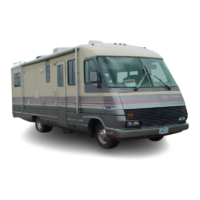48
Discovery, Discovery LXE, Pace Arrow, and Pace Arrow LXEt
If there is a difference in the
weights on one side of the vehicle
as compared to weights on the
other side, components (tires,
wheels, brakes, springs, etc.)
on the heavier side could be
overloaded, even though the total
axle load is within the GAWR.
It is important to redistribute the
load to avoid component failure,
as well as to improve the handling
characteristics of the vehicle.
With these actual weights, it is
now possible to compare them
against the GAWR, GVWR,
and tire capacities. These actual
weights are also what will be used
to determine proper tire inations
pressure. Options to help assist
when weighing the motorhome
include using “truck stop” scales.
There is usually a small fee for this
service.
Refer to the load ination table
published by the tire manufacturer
to determine proper ination
pressure recommended for
single and dual wheel positions.
The heaviest wheel position (if
applicable) on a single axle will
determine the ination pressure
for all tires on that axle due to
weight transfer that occurs when
cornering.
Dangers of Overloading
Do not overload the motorhome.
In addition to possible problems
with tires, wheels, and air springs
(air bags), there can be problems
of brake failure, drivetrain
failure, wheel bearing failure,
etc. Moreover, an overloaded
motorhome uses more fuel, is
more difcult to drive, and can
lead to driver fatigue. If any
component should fail, it could
result in vehicle damage and/
or loss of control. In addition
to the above dangers, there are
some states that require certain
motorhomes and RVs to utilize the
Highway Patrol’s weight scales
to check for overloaded axle
weights. Citations can be issued to
violators.
The motor home can be loaded
differently, depending on the
type of trip, loading and weight
patterns will change. Periodically
reweigh the motor home and log
the weights in this chapter. Refer
to the Weight Record Sheet to help
equate load distribution for future
trips.
Loading Tips:
Do not load heavy items on
the bumpers.
Secure and brace items so
they won’t move during
travel. Generally, load
heavier items lower.
Make a diagram of
your properly loaded
motorhome and keep a
log of the cargo. Then
weigh the motorhome. The
loading diagram, cargo log
and the loaded motorhome
weights will help to locate
where specic items are
stored, and will help speed
the loading process.
Fresh water and waste
water weigh over eight
pounds per gallon. Carry
only as much water as
needed for travel or to
balance the load, and
whenever practical, empty
the holding tanks before
traveling.
Store emergency items in a
readily accessible location.
As a minimum include a
re extinguisher, tools, rst
aid kit, rain gear, ashlight,
and highway warning
devices, an electric cord
with light and sturdy
gloves.
WARNING:
Modification of the
motorhome by addition
of racks not originally
equipped by the
manufacturer to carry
additional equipment,
vehicles or cargo will
reduce your warranty
coverage and may cause
personal injury or property
damage.
WARNING:
For safety, Do Not store or
carry propane containers,
gasoline, or other
flammable liquids inside
the motorhome.

